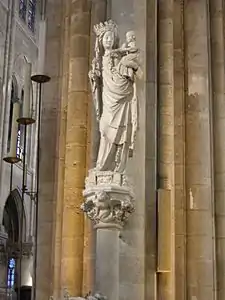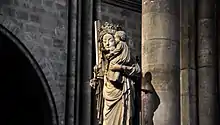Virgin of Paris
The Virgin of Paris or Notre-Dame de Paris is a near life-size stone statue, 1.8 metres tall, of the Virgin and Child created in the early 14th century. The statue was commissioned for, and remains in the Cathedral of Notre-Dame in Paris,[1] where it survived the 2019 Notre-Dame fire.[2] It is an example of the court style in Late Gothic sculpture.

The statue is in honour of the Blessed Virgin, mother of Jesus.[3] It retains an emotional appeal that links it to the Strasbourg Death of the Virgin.
Details
In this sculpture, Mary is shown standing, holding her son, Jesus Christ, against her body. Unlike previous renditions of this couple, both are naturalistic, with recognizable facial features. As usual in most religious sculptural depictions of the Holy mother and child of this time, Jesus does not look like a baby, but rather a miniature adult. However, the artist tried to combat this by giving the child the mannerisms of an infant as he plays with his mother’s veil and holds a ball. Mary stands in royal dress and a crown, depicting her as royalty. The ball her son holds is also an allusion to their royalty and holiness. The ball or orb in Christ’s hands is a reference to Christ as Salvator Mundi, or Saviour of the World. The orb symbolizes Earth, and how Christ is king of the entire world.[4]

Style
One of the main characteristics of Gothic sculpture was elegance. However, other changes occurred to sculpture, such as less enjambment into the background architecture, the contrasting of light and dark, and the Praxitlian ‘S’ curve. Gothic style moved away from the Romanesque style by simplification. The greatest change though was in sculptures separation from the architectural. Instead of having figures be created against walls or columns, sculptures were carved away from their supports. Also apparent in the piece is the contrast of shadow and light, made evident by the deep recesses in the clothes fabric.
The sculptor of Mary exaggerated the S-curve of her body, a signature element of Gothic style. However, the S-curve did not originate during the Gothic Period of Europe, but well before in Greece. In the 4th century BCE, Greek sculptors were enthralled by the body’s movements and muscles, and tried to capture complete naturalism through the S- curve. For Gothic sculptors, the desired effect was not of body movement, but of elegance and elongation.[5] However, by the beginning of the fourteenth century, or the start of the Late Gothic style, sculptures began to lack in volume. This extension and lightness is evident in Mary’s body.
See also
| Wikimedia Commons has media related to Madonna and Child dit Notre-Dame de Paris. |
Notes
- Base
- Vivienne Walt: An Exclusive Look Inside the Recovery Efforts to Save Notre Dame, Time.com, 11 July 2019
- Kleiner, Fred S. Gardner’s Art Through the Ages 13th Edition Volume 1. Boston: Thomson Wadsworth, 2009. Print.
- "The End of Europe’s Middle Ages.” The Applied History Research Group. University of Calgary, 1998. Web. 3 March 2012.<https://www.ucalgary.ca/applied_history/tutor/endmiddle/art3.html>.
- “Gothic Art & Architecture.” KATY School. Web. 3 March 2012. <http://kisdwebs.katyisd.org/campuses/MRHS/teacherweb/paze/Teacher%20Documents/Art%20History%20Teacher%20Notes/Gothic%20Art.pdf>.
References
- "Base" ="Base Palissy" (in French), entry in French government database of Monuments Historiques"
- “The End of Europe’s Middle Ages.” The Applied History Research Group. University of Calgary, 1998. Web. 3 March 2012. <https://www.ucalgary.ca/applied_history/tutor/endmiddle/art3.html>.
- Forsyth, William H. (1957). "The Virgin and Child in French Fourteenth Century Sculpture A Method of Classification". The Art Bulletin. College Art Association. 39 (3): 171–82. doi:10.2307/3047711. ISSN 0004-3079. JSTOR 3047711 – via JSTOR.
- “Gothic Art & Architecture.” KATY School. Web. 3 March 2012. <http://kisdwebs.katyisd.org/campuses/MRHS/teacherweb/paze/Teacher%20Documents/Art%20History%20Teacher%20Notes/Gothic%20Art.pdf>.
- Kleiner, Fred S. Gardner’s Art Through the Ages 13th Edition Volume 1. Boston: Thomson Wadsworth, 2009. Print.
